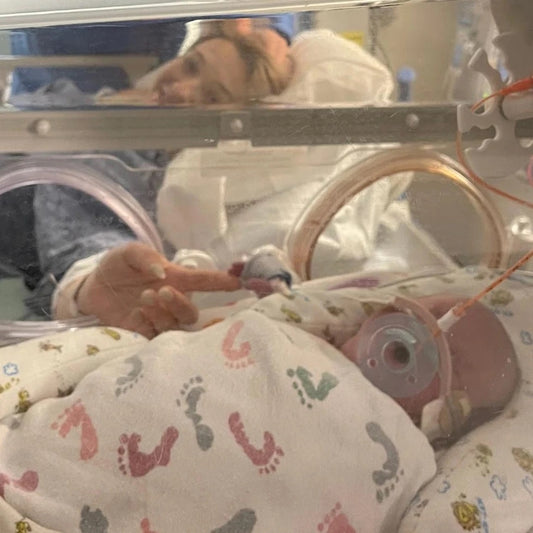This Is Why Skin-to-Skin Contact After a C-Section Is Crucial
Rohini MoreAbout 30% of babies are born in the United States by Cesarean section. While C-sections are performed regularly and with low risk, there are additional challenges associated with breastfeeding to understand.

According to the National Library of Medicine, a Cesarean birth can “reduce initiation of breastfeeding, increase the length of time before the first breastfeed, reduce the incidence of exclusive breastfeeding, significantly delay the onset of lactation and increase the likelihood of supplementation” (Stevens, et al., 2014).
There is a good reason we are sharing this daunting information:
skin-to-skin contact after birth, as well as continued skin-to-skin contact with your baby as a part of your regular routine, can decrease these challenges.
Every day brave mothers overcome these obstacles, form strong and loving attachments with their baby and breastfeed successfully. Research shows that practicing skin-to-skin contact after a C-section is a tremendous step towards bonding and breastfeeding success.
Major health organizations, such as The World Health Organization (WHO) and the United Nations International Children's Emergency Fund (UNICEF), recommend that mothers practice skin-to-skin contact with their newborn as soon as they are alert and responsive following their C-section delivery. Skin-to-skin contact has a wide range of benefits, specifically improved breastfeeding success, despite potential obstacles from a C-section.
Skin-to-skin contact after birth triggers babies’ natural instinct to search for food. This close interaction between a mother and her newborn also encourages mom’s body to respond by producing milk. The sound of mom’s heartbeat and voice, as well as her scent and the warmth of her body initiates nine healthy and natural behaviors: the birth cry, relaxation, awakening, activity, crawling, resting, familiarization, sleeping and suckling (Stevens, et al., 2014).
The literature review titled Immediate or early skin‐to‐skin contact after a Caesarean section concludes that
“early skin-to-skin contact after a Caesarean section may increase breastfeeding initiation, decrease time to the first breastfeed, reduce formula supplementation in hospital, increase bonding and maternal satisfaction, maintain the temperature of newborns and reduce newborn stress.” (Stevens, et al., 2014).
This research highlights the importance of continued skin-to-skin practice after families leave the hospital. Frequent skin-to-skin contact can decrease the odds of breastfeeding challenges by initiating breastfeeding, boosting mom’s milk supply and strengthening the bond between mom and her baby. Make this a part of your daily routine for at least the first six months of life.

Skin-to-skin contact is now common practice after birth due to the abundance of research that supports its importance. Most hospitals have implemented at least an hour of this special bonding time as standard procedure after vaginal delivery and cesarean delivery. This precious experience sets the stage for the healthy and loving bond between babies and their mothers.
WAIT, there’s more. Skin-to-skin contact after birth has been shown to benefit hospital staff as well because mothers and babies tend to be happier, healthier and have an easier time breastfeeding. Therefore, moms don’t need as much assistance from doctors and nurses when they begin their motherhood journey with the loving power of touch.
Is there anything skin-to-skin contact can’t do?!
Sources:
Stevens, J., Schmied, V., Burns, E., & Dahlen, H. (2014). Immediate or early skin-to-skin contact after a Caesarean section: a review of the literature. Maternal & child nutrition.
https://doi.org/10.1111/mcn.12128
https://pubmed.ncbi.nlm.nih.gov/24720501/




